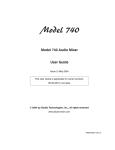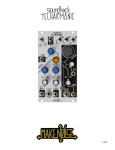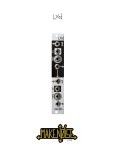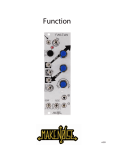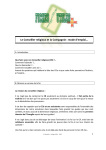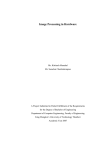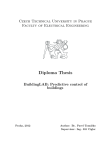Download Make Noise PHONOGENE Specifications
Transcript
PHONOGENE Limited WARRANTY: Make Noise warrants this product to be free of defects in materials or construction for a period of one year from the date of purchase (proof of purchase/invoice required). Malfunction resulting from wrong power supply voltages, backwards power cable connection, abuse of the product or any other causes determined by Make Noise to be the fault of the user are not covered by this warranty, and normal service rates will apply. During the warranty period, any defective products will be repaired or replaced, at the option of Make Noise, on a return-to-Make Noise basis, with the customer paying the transit cost to Make Noise. Please contact Make Noise for Return To Manufacturer Authorization. Make Noise implies and accepts no responsibility for harm to person or apparatus caused through operation of this product. Please contact [email protected] with any questions, needs & comments, otherwise... go MAKE NOISE. http://www.makenoisemusic.com THANK YOU Firmware engineer: Flemming Christensen (Gotharman http://www.gotharman.dk) Beta Analysts: Aaron Abrams, James Cigler Test Subject: Surachai Spiritual Advisor: Richard Devine. Special Thanx to Curtis Roads for his book “Microsound” Installation: The Make Noise Phonogene is an electronic signal processor/ generator requiring 70mA of +/-12V regulated power and properly formatted distribution receptacle to operate. It is designed to be used within the euroformat modular synthesizer system. Go to http://www.doepfer.de/a100_man/a100t_e.htm for the details of this format. To install, find 20HP of space in your euro-rack synthesizer system, confirm proper installation of included power cable on backside of module (see picture below), plug the 16pin end power cable into the euro-rack style power distribution board, minding the polarity so that the RED stripe on the cable is oriented to the NEGATIVE 12 volt supply line. This is USUALLY at the bottom. Please refer to your case manufacturers’ specifications for location of the negative supply. Proper installation of included power cable on module. Please note the RED BAND. OVERVIEW The Phonogene is a digital re-visioning and elaboration of the tape recorder as musical instrument. It takes its name from a little known, one of a kind instrument, used by composer Pierre Schaeffer. While it is not an emulation, it does share the primitive, tactile nature of its namesake, and expands upon the original concepts. It is informed by the worlds of Musique Concrète (where speed and direction variation were combined with creative tape splicing to pioneer new sounds) and Microsound (where computers allow for sound to be divided into pieces smaller then 1/10 of a second, and manipulated like sub-atomic particles). Having voltage control over every parameter, it is most dynamic as a digital audio buffer for the modular synthesist. The Phonogene is comprised of a pair of tool-sets, which work well together. Tape Music Tools allow for sounds to be recorded on the fly, layered using the internal Sound On Sound function, manually cut into pieces using the SPLICE function, and re-organized with the ORGANIZE control. Once it is spliced up, it is possible to create nearly infinite variations of the original loop by modulating the ORGANIZE parameter. VARISPEED allows for the speed and direction of playback to be controlled continuously with one control signal. GENE-SIZE, GENE-SHIFT and SLIDE make up the Microsound Tools. GENE-SIZE divides the audio buffer into progressively smaller pieces called Genes (aka particles, grains, granules). A clock signal applied to GENE-SHIFT will step through those pieces in chronological order, while a control signal (such as the Wogglebug Smooth CV) applied to SLIDE, moves through those pieces in a nonlinear fashion. Using SLIDE, random access of the audio buffer is possible. Obviously, functions such as VARI-SPEED and ORGANIZE are useful for Microsound as well, which is why these functions were grouped into one module. The end result is a sampler/ looper/audio buffer that is able to exist within a modular synthesizer system, and offer a vast amount of real-time sound manipulation in a fast and tactile way. PERSPECTIVE There is often the expectation that “bad sounds,” such as clicks, pops, distortions, wrong notes, phase inaccuracies and otherwise, should be impossible with modern musical instruments. Many designers are making instruments which are fool-proof, and which guarantee some specific musical result, thus making it easy to create the same music over and over again. The Phonogene does not use this approach. In fact, we have made it very possible to make the “bad sounds” and “mistakes” that have led to some of the greatest moments in musical history (and of course, some of the worst!). With the Phonogene, it is possible to Splice sounds in such a way that you will hear sharp contrasts, clicks and pops. This is the physics of sound! It is possible to slow down a recording to the point of complete decimation, so that all that remains is trail of digital artifacts. Such are the limitations of digital sound. It is possible to render the source material completely unintelligible, to cut busted loops, to distort digitally, to obscure, to regenerate to the point of almost no signal integrity. This is the nature of the Phonogene. If you seek the perfect looping tool, in the most contemporary sense of the word “loop,” then please look elsewhere. If you desire to explore the realm of modular, digital sample manipulation and microsound, read on! 3 4 5 1 2 22 6 23 7 8 24 5 25 9 10 11 12 26 7 27 9 28 13 14 15 16 17 18 19 20 21 PHONOGENE Panel Controls 1. Signal IN Rotary Level Control: For Line Level set at 70% CW, and for 10Vpp at set 30% CW. Faceplate is marked accordingly. 2. Signal IN: Line Level or typical Modular Synth levels acceptable. AC Coupled. 3. Sound On Sound CV IN: sets mix of previously recorded Loop with Live Signal input when recording, to allow for Sound on Sound type “overdubs.” Also allows for setting monitoring level of Live input signals with previously recorded Loop. May be misused as a Voltage Controlled Crossfader (between Live and Loop) or VCA for \ Loop (no Live Signal). Range 0V to 10V, linear response. Normalized to +10V. 4. Sound On Sound Attenuator: with nothing patched to SOS CV IN (which is normalized to +10V) works as standard panel control. With Signal Patched to SOS CV IN, works as attenuator for that signal. 5. Signal OUT: 10Vpp (depending upon Signal IN attenuator setting and source material), AC coupled. 6 & 7. VARI-SPEED and Splice Indicator LEDs: These LEDs tell user in which direction the Phonogene is playing. The LEFT Blue (7) LED indicates reverse playback, right Orange LED (6) indicates forward playback. When no LEDs are lighted, playback is stopped. PHONOGENE Panel Controls (cont’d) 8. VARI-SPEED CV IN: bipolar speed and direction control where 0V stops playback, positive control signal increases playback speed in forward direction, negative control signal increases playback speed in reverse direction. Range +/-4V. 9. VARI-SPEED Bipolar Panel Control: manual bipolar speed and direction control. When set to 50% playback is stopped, turning Clockwise from 50% increases play back speed in forward direction, turning Counter Clockwise from 50% increases playback speed in reverse direction. 10. VARI-SPEED CV IN Attenuvertor: bipolar attenuator for VARI-SPEED CV IN. 11. ORGANIZE CV IN: unipolar control signal input which selects next Splice to be played. The currently selected Splice will play to end before the next Splice is selected. The VARI-SPEED and Splice Indicator LEDs (6 & 7 ) will flash whenever this control finds a new Splice. Range 0V to +5V. 12. ORGANIZE CV Attenuator: unipolar attenuator for Organize CV IN. 13. ORGANIZE Panel Control: manual unipolar control which selects next Splice to be played. The VARI-SPEED and Splice Indicator LEDs (6 & 7 ) will flash whenever this control finds a new Splice. 14. PLAY Pulse IN: at each rising edge signal applied to PLAY Pulse IN, Phonogene triggers playback. At end of loop or splice, Phonogene looks at PLAY Pulse IN, if HIGH, it plays again, if LOW Phonogene does not play. This Input is normalized to be HIGH. So with nothing patched to PLAY Pulse IN, Phonogene will play continuously. Sees only rising edge of signal. Needs at least 1.5V trigger signal to operate. 15. RECord Pulse IN: toggles record on/ off. When recording from a cleared buffer, the first record cycle sets the record length, so be sure to perform the ERASE Routine to achieve a new recording. Sees only rising edge of signal. Needs at least 1.5V trigger signal to operate. 16. RECord button: manual, momentary button to toggle record on/ off. 17. RECord LED indicator: when lighted, Phonogene is recording. When not lighted, Phonogene is not recording. When flashing, Phonogene has entered the ERASE Routine. 18. SPLICE button: pushing drops splice marker on loop. When loop is Organized, the splices (resulting audio segments) are re-arranged according to the Organize control voltage as the Phonogene plays whichever splice is selected by Organize parameter. Since splices may be erased, this process is nondestructive. Holding this button for 3 seconds enters ERASE Routine (REC LED will flash to indicate the ERASE Routine). 19. SPLICE Pulse IN: input for using external signal to splice loop. Sees only rising edge of signal. Needs at least 1.5V trigger signal to operate. 20. End Of Splice OUT: outputs a short 4 ms pulse at the end of each splice. In the absence of Splices, EOS reflects end of loop, which is always present when a recording has been made. 21. End Of Splice LED indicator: lights to give visual feedback of End of Splice. PHONOGENE Panel Controls (cont’d) 22. SLIDE Bipolar Panel Control: manual bipolar panel control for scanning the pieces of sound that result from setting Gene-Size to greater than 10%. Moves/ slides through the Genes (aka grains). Allows for scrubbing of the recorded material and is always dependent upon the GENE-SIZE setting. 23. SLIDE CV IN: bipolar control input for SLIDE. Range +/-4V. 24. SLIDE CV IN Attenuvertor: bipolar attenuator for SLIDE. 25. GENE-SIZE CV IN: unipolar control input setting size divisor of audio buffer, dividing with respect to the buffer size as set by Record or Splice length. This parameter “auto-splices” the recorded material like a machine, with no regard to source material. Operates with great precision and the ability to cut pieces so small that the original source material is completely unintelligible. Nondestructive. At 0V there is no effect. Range 0V to +8V. 26. GENE-SIZE CV IN Attenuator: unipolar attenuator for GENE-SIZE. 27. GENE-SHIFT: clock signal at this input advances Phonogene to next Gene, in chronological order. Always dependent upon the GENE-SIZE setting. Needs at least 1.5V trigger signal to operate. 28. GENE-SIZE Panel Control: manual unipolar control which sets Gene-Size divisor. GETTING STARTED Erase Routine It is best to start with a cleared memory. To Reset the Phonogene and start fresh you need to enter the Erase Routine, where you may erase Splice markers and the Audio Buffer (aka Loop, aka Recording, aka Sample). To erase all Splices, press and hold SPLICE button (18) until the REC LED (17) starts flashing. All Splices are erased once the REC LED begins flashing. While still holding SPLICE button, and with the REC LED still blinking, the audio buffer may be erased as well by pressing REC button (16) once. If you do not press REC button, then your recorded audio will remain, and only the Splices will be erased. The Phonogene will continue to play the loop until you erase, and you should release the SPLICE button as soon as you have completed your desired Erase Routine. Signal To Be Captured! The Signal IN (2) has a gain control (1) that accommodates modular synthesizer signals as well as line level sources. Early electronic music composers often recorded pure sine waves to tape at different frequencies and amplitudes, and then edited and spliced these sounds into the musical phrases, but this was largely because there did not exist the means to control the electronic sounds. Laboratory instruments were being used as musical instruments, and these tools lacked the vast controls needed for musical expression. The arrival of the VCO, VCA and Sequencer made complete control of Frequency and Amplitude possible, on a time scale determined by the composer. Honestly, the most interesting source material for the Phonogene is not your synthesizer, but instead every other sound that surrounds you, so grab a microphone or patch into the internet and find some seemingly mundane sound to massage into a gorgeous, jumbled up symphony of micronoise. Recording Time and Quality Audio Buffer is 2MB, nonvolatile, high number of fast read and write cycles. Nonvolatile means the Phonogene remembers both samples and splices on power down. The high number of read and write cycles is key to longevity of the module, high speed read and write cycles allow for short sample times, making the microsound possible. Because the record and playback frequency is continuously variable from 88.2khz to 5.5khz by the VARI-SPEED control (8, 9, 10), the longest possible recording or loop length, is determined by the speed of Playback/ Record. Therefore, long recordings may be achieved, but at the cost of a lower sample rate, meaning the resulting recordings will be of lower sound quality. A “Mid-Fi” setting may be achieved by setting VARI-SPEED at around 50%, so that BOTH VARI-SPEED and Splice Indicator LEDs (6 &7) are OFF. This records with good quality, a 2 second record length, and allows for a good range of speed variation. Playback will be stopped while you record. Signal OUT That the Phonogene exist within the modular system is a huge advantage. Many Analog Synthesis techniques and processes will work well with the Phonogene. Creative filtering, especially Low Pass and Band Pass, will prove very useful in controlling the textures, clicks and aliasing of the Phonogene. Amplitude Modulation, Echo, Reverbare also commonly suggested post processing techniques in microsound and granular synthesis. Recording Process The RECord control toggles record on/ off. Starting with a Cleared Memory, pressing the RECord Button (16) once (or sending a single Pulse to RECord Pulse IN, 15) starts the recording process, and pressing RECord Button again (or sending a second, single Pulse to RECord Pulse IN) stops the recording process. If the end of the Audio Buffer is reached before the user stops recording, RECord automatically stops. The Phonogene begins looping the recording immediately upon completion of the record cycle (assuming the PLAY Pulse IN, 14, is held HIGH, which is the default state when there is nothing patched to the PLAY Pulse IN). It will be necessary to adjust the SOS control (4) so that the desired source (or blend of sources) appears at the Signal OUT. This initial recording sets the loop length, which is always minded, until the Audio Buffer is cleared (see Erase Routine, page 5). Sound On Sound Once the initial recording is made, the RECord function then allows for punch IN/ OUT within the loop, and layering of other sounds. Sound On Sound Control (3, 4) sets the balance of the Live Signal and previously recorded Loop Signal. While the Phonogene will not record in reverse, it will playback in reverse while recording for Sound On Sound, so it is possible to have two sounds playing in opposite directions. Once SOS is complete, remember to adjust the SOS control so that the desired source (or blend of sources) appears at the Signal OUT. Splicing The SPLICE button and SPLICE Pulse IN (18, 19), allows the user to non-destructively cut the loop into pieces, which are then selected for playback using the ORGANIZE parameter (11, 12, 13). To Splice, have the Phonogene set to playback the material to be spliced, and use either the SPLICE Button or SPLICE Pulse IN to drop Splice markers on the recording as it plays through. When playback loops around to the beginning, the Phonogene sees the new Splices, and looks at the voltage set by the ORGANIZE control in order to select which Splice to play. To preview your Splices, turn the ORGANIZE Panel Control slowly, and observe the VARI-SPEED and Splice Indicator LEDs (6, 7) for flashing to indicate new splice found. The newly selected Splice will not play until the currently playing Splice reaches its end, at which point the End Of Splice OUT (20) will generate a 4 ms pulse and the newly selected Splice will begin playing. The RECord function will mind the boundaries of the currently selected Splice. This will allow for replacing sounds within a musical phrase, or creating highly contrasting edits when building sound collages. To initiate RECord at the start of Splice, patch the EOS Pulse (20) to RECord Pulse IN (15). To erase Splices, enter the Erase Routine (see page 5). It is useful to slow and even stop the sound when Splicing, if precision is desired. To avoid clicks, slow the sound to find spaces or low amplitude regions in which to place Splices. Use your ears. If you want to Splice in real-time, let the loop play a few times, and learn the rhythm, thinking about where the up-beats fall, and try to drop splices on those up-beats. See the “Recycler” patch page 15 for “auto-splicing.” Another way to splice is to set the Gene-Size control as high as possible (without losing sound), and use SLIDE to manually scrub the sound. When you get to the desired point, press SPLICE, and a splice will be dropped at the start of the currently playing Gene. Turn Gene-Size back down to 0% and listen to the results. This is a highly useful trick for more precision splices, however, it is not as real-time and just manual dropping them as the loop plays. It is possible to manually Splice into the microsound range (down to about 10ms). This is an excellent technique to experiment with since it allows for many different sizes, where as GENE-SIZE parameter sets a uniform size for all pieces. Additionally ORGANIZE treats Splices differently than the SLIDE treats the Gene, since ORGANIZE will wait until the current Splice reaches the end before moving to the next selected Splice. This often has less glitches as the sound is traversed. A world of micromontage awaits. Re-Organizing Splices ORGANIZE is the one control on the Phonogene that is not instantaneous. Turning the panel control or modulating ORGANIZE, the VARI-SPEED and Splice Indicator LEDs (6,7) flash indicating new splice found, however, the newly found Splice will not be selected for playback until the currently playing Splice reaches its end, at which point the End Of Splice OUT (20) will generate a 4 ms pulse and the newly selected Splice will begin playing. The ORGANIZE parameter was designed for sequential control sources, such as René or Pressure Points. The range is smaller than the other control inputs, reflecting the typical 5Vpp range of analog sequencers. It is worth considering that the human ear is more sensitive to incongruences in pure and simple waveforms, so for example, recording a SINE wave of constant amplitude and Splicing WILL result in audible clicks, while recording speech and splicing is not as likely to have audible clicks. Speed Variation, Direction Variation There is one control associated with both direction and speed, and that control is VARI-SPEED (8, 9, 10). Also there are LED indicators (6, 7) which show direction of playback. At 50% VARI-SPEED is at 0, and playback is stopped. Neither of the associated LEDs will be lighted. Turning Clockwise from 50% increases playback speed in forward direction, turning Counter Clockwise from 50% increases playback speed inreverse direction. VARI-SPEED has a wide range, with increased resolution toward the center of it’s range, thus giving the control a nice feel when “braking” playback with a smooth control voltage. For “Wow & Flutter” effects, modulate with greatly attenuated smooth random voltage (such as Wogglebug Woggle CV), setting the on board attenuator nearly to 50% (nulled). Sequencing the speed of playback is also very pleasing when combined with sequencing of the ORGANIZE parameter. Stopping Playback, Starting Playback, Re-Triggering Sounds When VARI-SPEED (8, 9, 10) is at 50% the Phonogene has slowed to a halt. When VARI-SPEED is set to greater or less then 50%, playback will start from where it was halted. The PLAY Pulse IN will also stop and start playback, but in a very different way. At the end of each loop or splice, the Phonogene looks at the PLAY Pulse IN (14), if it is high, then Phonogene continues to play, if it is low, Phonogene stops at end of loop or splice. In this way, the PLAY Pulse IN, will always play the loop or splice from the beginning. PLAY Pulse IN may also be used to re-trigger sounds, since it is essentially looking for a change in state, from low to high. If you send repeated pulses to PLAY while VARI-SPEED is set for playback, you will achieve the classic re-trigger effects. PLAY and VARI-SPEED respect each other, so for example, if VARI-SPEED is set to 50%, a pulse at the PLAY IN will not trigger playback, since the playback speed is effectively zero. Microsound Microsound includes sounds shorter than musical notes, and yet longer than single samples. The sound is essentially a cluster of samples contained in an amplitude envelope. The Phonogene offers two methods “Micromontage” and “Granulation.” Micromontage is done manually using the SPLICE function to cut the sound into pieces, and the ORGANIZE parameter asynchronously plays through those pieces. It is possible to splice sounds down to 10ms. It is an interesting process that allows for a great deal of variation, but it requires patience since the sound is cut up manually to achieve such variation. Granulation is an automatic splicing of the sound. It is done without regard to source material, and is a linear, machine like process, dividing the audio buffer into progressively smaller pieces. If the individual Samples that comprise a digitally recorded sound recording make up the DNA of the sound, then we would refer to these small clusters of samples as Genes. The Phonogene is a Single Gene device, meaning that one cluster of samples is heard at a time. The Phonogene uses Dynamic Enveloping to achieve smoothing of the audible glitches that result from performing these particle physics studies upon audio signals. At a certain point, the size of the Gene is so small that it will be heard as a click. This is still useful because there are many ways to vary the timbre of that click, and when hundreds of clicks are heard one after the other, the ear will perceive them as a tone with varied timbre. The same is true of the Micromontage method, but Granulation is an automatic, real-time process, and therefore may be modulated by control signals within the modular system. Additionally, the GENE-SHIFT Clock IN allows for strict Synchronous playback of the resulting pieces, which is useful for Time-Stretch/ Compress and other effects. It is recommended that LP or BP filter follow the Phonogene when performing granulation, to allow for further control of the resulting sound. Setting Size of Genes The GENE-SIZE control parameter sets the divisor value. The smallest possible Geneis 1/12th of the splice length. If there are no splices, the smallest possible Gene is 1/12th of the total loop length. Therefore, the SPLICE and ORGANIZE functions will prove useful for building sets of Microsounds. For example, if you have 4 Splices, and each is a different length, then each splice will offer a different range of Gene sizes. Heard un-modulated the single Gene sounds almost as if it were oscillating, and modulating the VARI-SPEED control will change the perceived pitch of this oscillation, just as you would modulate the pitch of a VCO. Modulating the GENE-SIZE will effectively change the perceived pitch as well as the timbre, and could be likened to varying the level of magnification while inspecting a microscope slide. Slow continuous signals, such as MATHS, triggered or cycling, will prove very good modulators for GENE-SIZE. Traversing Sound on a Genetic Level in a Nonlinear Way As interesting as the single Gene may sound while modulated, you will find that exploring all the different Genes in a given Splice via modulation of the SLIDE parameter will be even more thrilling. The sonic contrast of the different Genes and the order in which they are heard will generate a wealth of new sounds from your source material. SLIDE (23) will always move immediately to the next Gene, so modulating with stepped voltages will often result in fast hard timbral changes as you move from one cluster of samples to another. Continuous signals, such as MATHS, triggered or cycling, will prove very good modulators for SLIDE. The SLIDE Panel control (22) sets the center point for the modulation and the SLIDE CV Attenuvertor (24) could be seen as setting the “window” of the modulation, since it will control the range of Genes played. Chronological Inspection of the Sound DNA Using the GENE-SHIFT Clock/ Pulse IN (27) it is possible to play through the Genes in Chronological order. This is Synchronous Granulation. At the rising edge of each Clock or Pulse, the Phonogene will jump to the next Gene, and will play that Gene at the rate and direction determined by VARI-SPEED, until the next Clock or Pulse arrives at the GENE-SHIFT IN. Modulating VARI-SPEED and GENE-SIZE while clocking through the Genes is very pleasing. This is also useful for syncing timbral shifts or for performing crude Time Stretch and Compress (see patch ideas page 13). Synchronizing the Phonogene The Phonogene has three timing inputs and one timing output. The PLAY, RECord and GENE-SHIFT Clock/ Pulse INputs are all useful in synchronizing the Phonogene. The EOS Pulse OUT is useful for synchronizing other events to the Phonogene. Patching a timing source or event source such as Clock, Pulse, Gate or Trigger signal to the GENE-SHIFT IN will step through the individual Genes of your sound in time with that source. Additionally the GENE-SIZE setting will further effect this process, since the length of the Gene with respect to the length of the Clock Cycle will result in either Time Compression or Time Expansion. If the GENE-SIZE is shorter than the Clock Cycle, the Gene will play more than once before the next Clock arrives, and will thus result in Time Expansion. If the length of the GENE-SIZE is longer then the Clock Cycle, then the Gene will not play in its entirety, samples will be skipped or dropped, and the result is Time Compression. Interesting timing sources are clock multipliers (4ms SCM), PLL (Doepfer A-196), clock dividers and oddly enough, the manual gates generated by Pressure Points. Tapping the Pressure Points to supply a “human clock” to jump through the granulated loop is very pleasing. Patching a Clock or Pulse signal to the PLAY Pulse IN, allows for triggering and retriggering of the Loop at rate of Clock or Pulse. This input could be used like the Reset input on an LFO, so patching a division of your master clock so that the loop is periodically pulled back into sync with the rest of the patch. Patching a Clock or Pulse signal to the RECord Pulse IN, allows for Recording and applying Sound On Sound at rate of Clock or Pulse. This usage is best shown in the Regenerative Record patch (see page 14). Phonogene v.372 update Note: All new Phonogenes shipped after July 2013 will be loaded with firmware v.372. This update includes the following improvements: -Improved Audio Fidelity -Improved Vari-speed Response (shorter scale, greater resolution) -End of GENE Pulse: EOS outputs pulses for both Splices and Genes. Turn up Gene Size to see this in action. -Longer Record TIme: Improved memory management and fidelity, making longer recordings possible. -Double trigger at EOS while Vari-Speed set for Forward playback is fixed. HIDDEN FUNCTIONS/ ROUTINES “Mid-Fi” Record: this setting may be achieved, by setting VARI-SPEED at around 50%, so that BOTH VARI-SPEED and Splice Indicator LEDs (6 & 7) are OFF. This records with good quality and a 2 second record length, which is great length for venturing into a Microsound opus. Erase Routine: to erase all Splices, press and hold SPLICE button (18) until the REC LED (17) starts flashing. All Splices are erased once the REC LED begins flashing. While still holding SPLICE button, and with the REC LED still blinking, the audio buffer may be erased as well by pressing REC button (16) once. PLAY Pulse IN (14): this input is normalized HIGH, so that with nothing patched, the Phonogene will always play according to VARI-SPEED setting. Patching something to this input WILL stop the Phonogene, if the applied signal is below 1.5V SOS CV IN (3): this control input is normalled to +10V and is connected directly to the SOS Attenuator (4), therefore with nothing patched the SOS CV IN, SOS Attenuator acts as a panel control for the parameter, by setting an offset. Broken ECHO Mode: All new behavior allows for realtime processing of audio signals. To enter broken Echo Mode, create a sample/loop/Splice (just press REC button and record enitre memory bland, for example), press and hold REC button until you pass through the EOS (EOS flashes) and RECORD will be stuck ON. Exit Broken Echo, just hit REC button again (do not HOLD it though, or you will go back into Broken Echo). In this mode the Phonogene is similar to the Echoplex with the SOS switch activated or that trick that William S. Burroughs used where he covered the Erase head of a tape recorder and allowed a spool of tape to be recorded over and over and over again without erasing the previous recordings. This is a great mode for building walls of sound, drones, or making crude echo FX. Phonogene will still mind Splices and Vari-Speed, Gene Size, Shift, and Slide-All functions. Any modulation of these parameters will be recorded. Be sure to set the Mix control according to your desired results. For example, live input processing will require the Mix to be set at around 50% while massaging content that has been capturedw ill need Mix set to 100% Wet. Adding or removing splices during Broken Echo Mode is not supported. Patch IDEAS For all Patch Ideas, assume Signal Patched to Signal IN and INput level set for maximum level without distortion, GENE-SIZE and ORGANIZE Panel Controls at 0% and Erase Routine has been run so that Phonogene memory is cleared. Sound Collage: Record. Set VARI-SPEED (9) for desired speed and direction. Splice Recording manually, or with Pulse/ Clock Source, at random or with care. Use ORGANIZE (13) Panel Control to select any Splice. Apply a different Signal to Signal IN. Set SOS (4) for desired mix of Live Signal and Loop Signal. Patch EOS (20) to RECord Pulse IN (15), Phonogene will begin recording at next pass, remove EOS from RECord Pulse IN once desired SOS is achieved. Repeat the italicized steps many times, using different Splices and different Signals and setting VARI-SPEED for different speeds and directions each time. When you are satisfied with the level of confusion, press and hold SPLICE button (18) until the REC LED (17) starts flashing. Listen to the entire collage. Time Stretch/ Compress (aka Universal Phonogene): Record loop. Set VARI-SPEED(9) for desired speed and direction. Patch Clock signal to the GENE-SHIFT IN (27). Set GENE-SIZE (28) to at least 40%. Phonogene will step through the individual Genes of your sound in time with that Clock. Additionally the GENE-SIZE setting will further effect this process, since the length of the Gene with respect to the length of the Clock Cycle will result in either Time Compression or Time Expansion. If the GENE-SIZE is shorter than the Clock Cycle, the Gene will play more than once before the next Clock arrives, and will thus result in Time Expansion. If the length of the GENE-SIZE is longer then the Clock Cycle, then the Gene will not play in its entirety, sample will be skipped or dropped, and the result is Time Compression. Additionally, modulating GENE-SIZE with slow LFO, such as MATHS will re-create the effect of a Flux Capacitor. Sliding Phonogene: with a sound already recorded into the Phonogene, set VARISPEED to 50%, so that playback is stopped. Patch the Press CV from column 1 of Pressure Points to Channel 1 of MATHS. Patch the Press CV from column 2 of Pressure Points to Channel 4 of MATHS. Set the RISE and FALL of both CH. 1 and 4 to around 65% and VARI-RESPONSE of both channels to “loggish.” Set MATHS CH. 1 scaling full counter clockwise so that the resulting signal is inverted. Set MATHS CH. 4 full clockwise. Null MATHS CH. 2 and 3. Patch MATHS SUM OUT to Phonogene VARI-SPEED CV IN and set the associated attenuvertor to about 70%. Use pressure placed upon Pressure Points touch-plate 1 and 2 to control the Speed and Direction of Phonogene playback. For the Infinite Benefit of Mr. Kite: VARI-SPEED (9) at around 70%. Press Record and let it run to end. Now drop Splice markers on the empty recording as it plays through. Drop at random. Using ORGANIZE(13), select a Splice. Patch Sound to Signal IN (2). Set SOS (4) to Full Counter Clock-wise. When you are ready to record, patch EOS OUT (20) to RECord Pulse IN. EOS will trigger RECord ON. Once Sound is recorded, remove EOS from RECord Pulse IN. RECord will go to End Of Splice and turn OFF. Repeat italicized steps until each empty Splice is filed with different sounds. Patch EOS to Wogglebug Clock IN. Patch Wogglebug Stepped CV to ORGANIZE CV IN, and set associated attenuator for 50%. Enjoy. Regenerative Record: with nothing patched to Signal IN (2), and VARI-SPEED (9) at around 70%. Press Record and let it run to end. Set-up Sequence or some sort of clocked patch with Sequenced Sound Source (VCO->LPG) patched to Phonogene Signal IN. Drive LPG with division of Master Clock. Master Clock => Clock Divider /4 => Wogglebug Clock IN /8 => Phonogene RECord IN (15) /1 or /2 or ??? => Phonogene GENE-SHIFT IN (27) Wogglebug Stepped OUT => Phonogene GENE-SIZE CV IN (25) (set corresponding attenuator to about 50%) (26) Wogglebug Woggle OUT => Phonogene VARI-SPEED CV IN (8) (set corresponding attenuvertor to 40%) (10) Start sequence. Listen to the mess you've made. EchoPhon: with nothing patched to Signal IN (2), and VARI-SPEED (9) at around 70%. Press Record and let it run to end. Splice the empty recording so you have multiple splice lengths, long to short. Apply signal to be processed to Signal IN, set gain accordingly. Patch EOS (20) to RECord Pulse IN (15). Set SOS (4) to 50%. Increasing SOS parameter will create more repeats in the echo. Set or Modulate Organize to change echo times. Modulate Vari-Speed and other parameters to taste. Recycler: Record. Mult the Signal out, and patch to Signal IN MATHS Channel 1. Set MATHS Channel 1 RISE and FALL so that the Activity LED is Flashing in time with the transients of the recorded sound. This will usually put RISE at around 60% and FALL at around 50%. Patch a dummy cable, or a manual gate, such as Pressure Points Gate OUT, to Phonogene PLAY Pulse IN (14). Let Phonogene play to end of recording. Once playback has reached end and stopped, patch the MATHS Channel 1 End Of Rise OUT to Phonogene SPLICE Pulse IN (19). Now let Phonogene play through the recording ONCE by either pressing manual Pulse once or removing the dummy cable and then immediately re-inserting once playback has started. When Phonogene has played entire recording once, and is stopped, remove MATHS EOR OUT from Phonogene SPLICE Pulse IN. There should now be nothing patched to Phonogene SPLICE Pulse IN. Remove the dummy cable or manual Pulse from Phonogene PLAY Pulse IN. Using the ORGANIZE Panel Control (13), audition the resulting Splices. If not acceptable, press and hold SPLICE button (18) until the REC LED (17) starts flashing, re-install the cables to PLAY Pulse IN and then SPLICE Pulse IN, adjust the MATHS RISE and FALL settings, and perform italicized steps again. Once you are satisfied with results, utilize the ORGANIZE parameter to re-organize your loop. Try patching stepped/ clocked control sources to ORGANIZE, such as sequencers (René) and sample & hold (Wogglebug Stepped OUT). Sound Replacer: perform above Recycler patch. Once you have sounds isolated within Splices, select the Splice containing sound to be replaced using ORGANIZE Panel Control (13). Patch new Sound to Signal IN (2). Set SOS (4) to Full Counter Clock-wise. This next step is optional, patch EOS to trigger new Sound (perhaps use VCA and Envelope to control new sound). When you are ready to record the replacement, mult EOS OUT and patch to RECord Pulse IN. Once Sound is replaced, remove EOS from RECord Pulse IN. When you are done replacing sounds, press and hold SPLICE button (18) until the REC LED (17) starts flashing. Listen to the results. Firmware 372h Patch Examples Tempo-Locked Reversible Granular Echo: EOS -> Wogglebug Clock EOS (multed) -> DPO Strike Wogglebug Stepped Random -> DPO 1v/Oct DPO Final -> Phonogene IN Engage Broken Echo mode. Adjust Wogglebug Chaos Balance control to taste to choose melodic range. Adjust SOS to ~1:00. Adjust or VC Gene Size, Varispeed, Slide and direction to “play” the patch. Granular exploration will be recorded into the buffer, and all echos will be synced to the incoming strikes from the DPO, even if echos are being played backward. It’s Gonna Come Out: Engage Broken Echo Mode, and patch a sequence with Rene. Adjust Varispeed so that the loop time is close to identical to the length of the sequence. (Alternatively, use the End of Splice trigger to clock the Echophon, multiply the Echophon Tempo, and clock Rene with Echophon Clock Out). Patch sequenced audio to Phonogene IN. Adjust SOS to between 9:00 and 3:00 according to tast. Each loop of the melody will be slightly out of time with the previous as they stack on each other, creating rhythmic and phasing effects. This patch will also work nicely with looped concrete audio: try freezing it in the Echophon buffer. Genetic Mosaic: With Gene Size turned up to 9:00 or farther, patch EOS to REC in, and mult EOS to Gene Shift. Overdubbing takes place over half of the genes (every other gene). Unpatch from REC and change the gene size, then repeat. After several variations have been overdubbed at different gene sizes, unpatch from REC again and adjust Gene Size to full CCW. Listen to the mess you have made. Because gene sizes are all powers of 2, the result is sure to be rhythmic. Erase and try again if unpleasant.
















